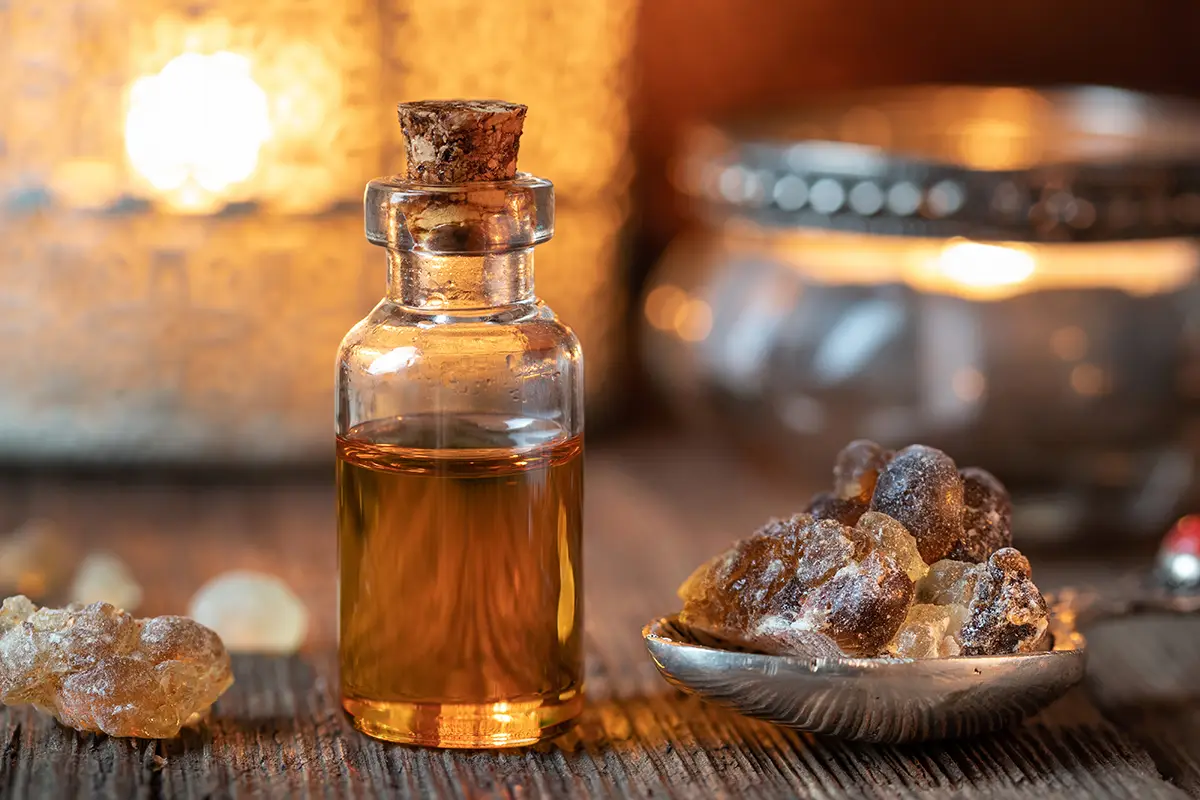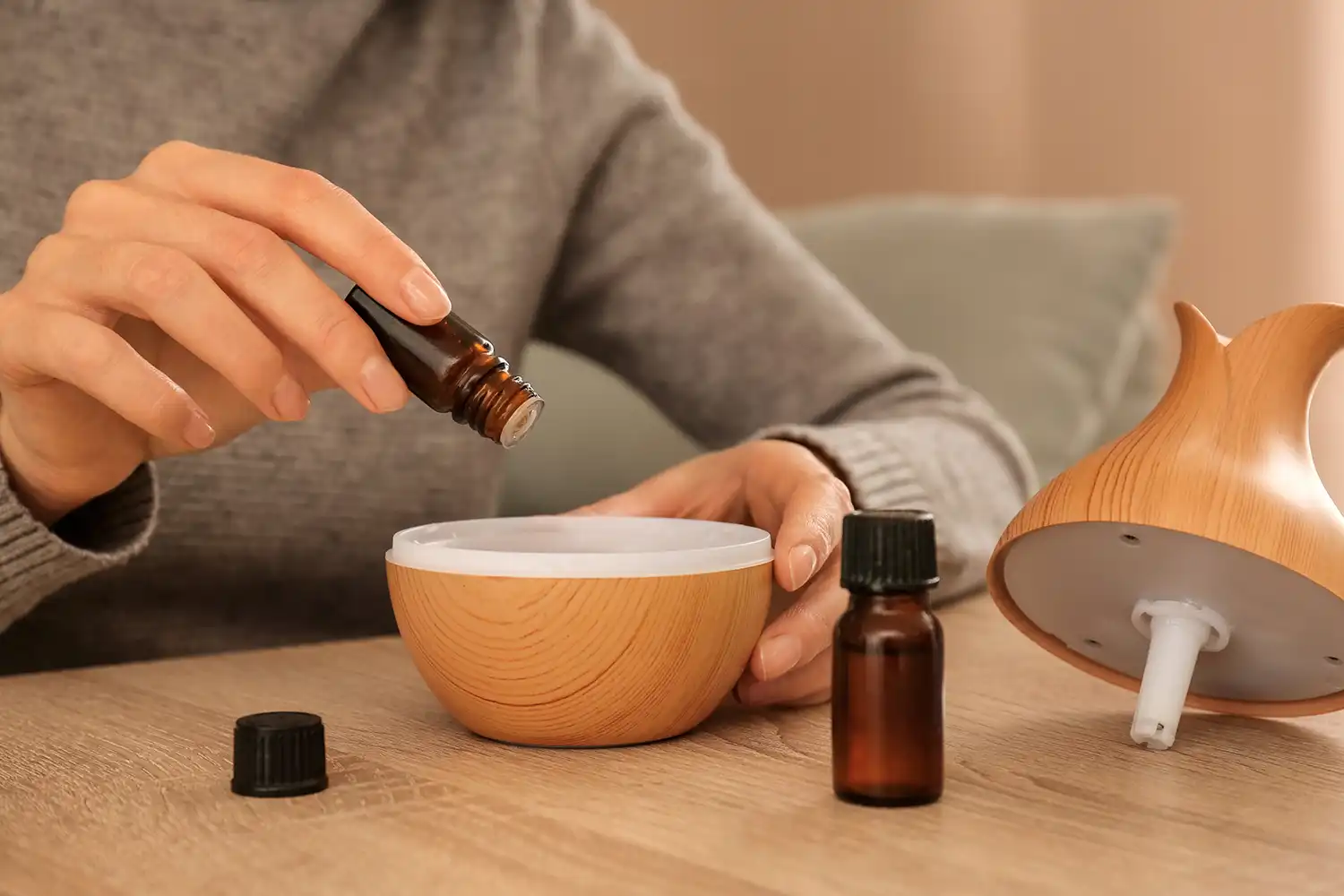Introduction to essential oils
Essential oils (EOs) have been used for centuries to treat various health problems, including the common cold and flu. Recently, their popularity has grown hugely as people have become more aware of natural home remedies. But, if you’re new to essential oils, you may not be sure which ones to use and how to use them effectively and safely. In this blog, we have collected our top recommendations for specific oils to use during the cold and flu season. You will learn which ones are best to use when you feel the first signs of a cold or have already developed the symptoms. We’ll also give you some essential advice on using them safely and effectively.
Benefits of using essential oils for cold and flu relief
Whilst over-the-counter medications can help treat symptoms, they don’t necessarily prevent them from spreading or recurring. Natural plant oils are an excellent option for people who want to reduce the common cold and flu symptoms and avoid spreading them to others.
There are many benefits to using essential oils for cold and flu relief.
Certain oils can help boost your immune system, which may leave you better equipped to fight off the bugs causing your sickness.
Other oils that may help you feel an opening up of your airways can be inhaled, relieving congestion and breathing difficulty.
Applying topical preparations, such as balms or rubs containing essential oils, can alleviate muscle discomfort often associated with colds and flu.
What is the best essential oil for colds?
There is no one “best” answer as different oils work on various aspects, with some oils working better on some people than others. However, the following essential oils are well known to help with cold symptoms such as congestion and sore throat.
Due to its potent anti-inflammatory effects, Eucalyptus essential oil is often considered the go-to for cold and flu season. It is also excellent for cleansing the air in a sick room, potentially reducing the spreading of infection. In addition, its antiviral benefits are recognised for respiratory tract diseases.
Niaouli essential oil is a mild analgesic for aches and pains and a strong stimulant for your immune system. It helps ease chest congestion, but some people find the aroma a bit “medicinal”.
Fir Balsam is another antiseptic, antimicrobial, and anti-inflammatory oil. It is a strong analgesic for sore muscles and aching joints. It can also lift your mood and be energising, so it is best used during the day.
Peppermint essential oil can also relieve congestion by loosening up mucus and reducing inflammation in the sinuses. Research found that it relaxed the bronchial muscles to help with breathing. The menthol is also warming and soothes aching muscles.
Rosemary essential oil verbenone is the better choice of all the rosemary varieties as it has a lower camphor content and is less potentially irritating. It eases muscular pain and also helps clear the airways. Avoid using rosemary if you have epilepsy.
Tea Tree is an antiviral, antiseptic, and antimicrobial oil, which makes it a powerful, natural disinfectant.
Frankincense essential oil helps slow your breathing and enables you to breathe deeper. In addition, it’s antiseptic, anti-inflammatory, and an astringent that helps dry out your blocked sinuses. Best of all, it can be helpful to break up mucous and dissolve phlegm, which helps you get a better night’s sleep.
Thyme essential oil has strong antiviral properties and is a good decongestant. In addition, research shows it to be effective against respiratory tract disease. However, this oil should be used with care as several varieties can cause adverse health problems if not used safely. Consult an Aromatherapist for advice.
Lavender essential oil offers a more calming approach to alleviating symptoms such as headaches, nausea and fatigue. In addition, it helps shift difficult phlegm in the chest and makes all the other oils it blends with work better.
Lemon essential oil can help improve airflow in your nasal passages, making breathing easier. It also helps to reduce swollen glands and relieves muscular aches and pains while helping to gently uplift your mood calmly.
Ravensara oil is not so well known and has a strong aroma. Despite that, it boosts overall immune health and blends well with Eucalyptus for muscular issues. Always seek advice from your PEOT.
Cajeput essential oil is related to Tea Tree, and apart from easing chest congestion, it can relieve a thumping tension headache.
A research paper on respiratory tract diseases highlighting the use of Eucalyptus, Peppermint Tea Tree and Thyme oils showed just how effective they were when inhaled.
Read More – Boost Your Mood: The Magic of Uplifting Essential Oils.

How essential oils work to treat colds and flu
Essential oils are derived from aromatic herbs and other plants and are known for their strong, therapeutic aromas. Many essential oils are anti-inflammatory and reduce the inflammation of the nasal passages, making breathing easier. This can also relieve pressure headaches and sinus pain. In addition, certain oils stimulate the body’s natural defences and have antiviral and antibacterial properties.
What aromatherapy is good for a cold?
When we think about what it is about the common cold that bothers us the most, it is usually a runny nose or a blocked nose, followed by general pain all over the body. As a result, many people dread coming into the cold and flu season.
The active ingredients in EOs interact with the body’s physiology, providing multiple health benefits depending on the oil. For example, some oils can help reduce inflammation, stimulate circulation and increase immunity, which is beneficial for treating colds and flu symptoms. Not only that, but many of these compounds have antiseptic qualities, which can help soothe throat irritation, reduce congestion, and support the respiratory system.
How do you use essential oils for colds and flu?
Using essential oils for colds and flu is easy. There are several options depending on what you prefer, and you can combine them.
Dusing them into the air is an excellent way to treat yourself or your family during the cold and flu season. This allows you to benefit from them as they enter the bloodstream through the lungs. They can help reduce cold and flu symptoms, such as headaches, sore throats, and congestion. It’s important to avoid overdoing this by diffusing too many drops of essential oil – just 1 or 2 drops is enough to be effective.
They can also be added to a carrier oil and applied onto the skin as a topical rub. Most people would think to do this on the chest, but they are also very effective when applied to the soles of your feet (put some socks on afterwards, so you don’t slip!).
When added to a base cream, balm, or gel, they can help reduce the symptoms of colds and flu more easily. In addition, they can ease aches and muscular discomfort often associated with the flu.
You can add a drop of oil onto a tissue and tuck it into your pillowcase at night. You can also add several drops into your washing machine’s final rinse compartment to disinfect your bedding when washing it. This will make your bed smell wonderful!

Common essential oils used to fight cold and flu symptoms
Many of the single oils mentioned also work well when made into blends with other essential oils, also called synergies. These are great when you diffuse them in your home as the combination can be lovely, and you can swap them around in different rooms. We bet you will use some of these blends even when your sickness is long gone. Just make sure you don’t use them neat on your skin!
Blends to boost your immunity
9 drops Grapefuit EO + 8 drops Lemon EO + 3 drops Ravensara EO. Citrus oils like Lemon oil and Grapefruit oil are happy oils that boost your immune system, and Ravensara helps your immune system stay strong.
9 drops Rosemary Verbenone EO + 8 drops Lavender EO + 3 drops Cajeput EO. The lavender helps the other two oils work harder for your immune system.
Blends to purify the air
13 drops Orange EO + 5 drops Ginger EO + 2 drops Cinnamon EO. This blend may also make you think of Christmas, but it is a good choice for any time of year.
11 drops Lemon EO + 7 Eucalyptus Globulus EO + 2 drops Thyme EO. This blend is strongly effective against harmful germs, so use it sparingly and rotate it with other blends.
Blends to ease nasal congestion
9 drops Frankincense EO + 8 drops Eucalyptus EO + 3 drops Peppermint EO. Frankincense helps you to breathe slower and deeper, while the other two oils dramatically reduce inflammation.
9 drops Cedarwood EO + 8 drops Lavender EO + 2 drops Eucalyptus EO + 1 drop Roman Chamomile EO. This combination is gentle in its action but still very effective. There are many different kinds of Chamomile essential oil, but Roman Chamomile oil is different because it has a fruity aroma. This oil blend is good to use all year round.
Blends to ease chest congestion
2 drops Eucalyptus EO + 2 drops Frankincense EO + 1 drop Myrrh EO with 4 teaspoons of carrier oil (approx 20g – 25g). Massage this onto your chest and back, right up over your shoulders. Use morning and night.
4 drops Lavender EO + 1 drops Peppermint EO + 1 drop Lemon EO with 5 teaspoons of carrier oil (25g – 30g). This can also be applied to the soles of the feet (put socks on afterwards).

What oils are good for cold and flu?
The most popular EO for treating colds and flu is Eucalyptus. Its natural antibacterial properties make it an excellent choice for preventing the spread of germs, while its aroma helps clear nasal passages. For the best results, starting diffusing Eucalyptus oil in your rooms at the first signs of getting sick is recommended. This will help prevent colds and flu from spreading throughout the household.
There are several varieties of Eucalyptus, each with specific benefits. To get you started, get the Eucalyptus globulus variety for general use. If you have children, you should get the Eucalyptus smithii variety.
Tea Tree oil is another popular remedy whose natural antiseptic properties help fight bacteria, fungi and viruses that could lead to illness. Its pleasant aroma keeps you calm and relaxed.
What essential oil is best for cough and congestion?
Peppermint EO contains menthol, which helps relax muscles in the respiratory tract, encouraging the expectoration of phlegm. It can also help to reduce the feeling of fever and a scratchy throat.
Frankincense EO relaxes the intercostal muscles (the muscles between your ribs). This allows a greater expansion of your chest when you are breathing, which may help you oxygenate your system better.
Eucalyptus EO is also great for treating upper respiratory infections as it reduces inflammation, making it an effective decongestant.
Is Frankincense good for flu?
Absolutely! Research has shown that it reduces inflammation and pain and is even used in severe diseases. The anti-inflammatory properties of Frankincense reduce inflammation associated with the flu virus. It can be helpful to support clearing some nasal congestion and breaking up phlegm in the lungs.
You can get a bowl of hot water and put a drop of Frankincense oil in it. Lean over the bowl with a towel over your head to capture the evaporating vapour — the Frankincense and the steam help to loosen and dissolve stubborn congestion. Please don’t use more than a drop, as it is unnecessary; too much could make your eyes sting a little. This method goes back centuries – and it works!
If you (or the person you are looking after) are lying back in bed, you can rinse a flannel in hot water with the oil and rest it on the forehead or chest, which will also feel helpful.
How to use essential oils for cold and flu symptoms
There are many ways to get the medicinal properties of essential oils working hard for you.
Add EOs to a diffuser for general use around the home and in a sick room.
Add oils to a bowl or hot water. Lean over the bowl with a towel over your head. The steam inhalation helps to loosen mucous and phlegm.
You can also use the warm water as a hot compress on the forehead, chest, or back.
Add a drop of oil to a damp cotton ball and tuck it into the vents of a radiator.
Make a blend of essential oils and add them to a carrier oil to be rubbed.
This carrier oil blend can also be added to bath salts and milk (be sure to rinse the bath well afterwards).
The same blend can be added to a large plastic bowl or box of warm-hot water to soak your feet in.
Add different oil combinations to a balm, base cream or gel. These are easy to make for yourself.
Can diffusers help with colds?
The short answer is yes! Diffusing EOs such as Peppermint, Eucalyptus, Tea Tree, or Lavender oil can help reduce cold symptoms. Inhaling these aromatic oils can also help relax the body and mind, clear nasal passages and sinuses, and boost the immune system. All of these can help reduce the duration of your cold.
If you don’t have a diffuser, put a few drops on kitchen paper and rest it on a radiator.
What should I diffuse for cold and flu?
When you feel that you are starting to come down with a cold or the flu, using the right EOs can make all the difference. It is a great way to help clear the air in your home, which will help reduce the risk of infection for you and your family. In colder temperatures, viruses travel faster, so you are more likely to spread infections at night, and you may cough or sneeze in your sleep. Try these simple, homemade blends for your diffuser; mix them in a small bottle to use a few drops when needed. Ensure you keep them out of reach of children and pets, and don’t use them undiluted on your skin!
7 drops Lemon EO + 7 drops Tea Tree EO + 6 drops Eucalyptus EO. The Lemon essential oil boosts your immune system, the Tea Tree is antibacterial and clears your sinuses, while the Eucalyptus is decongestant, antibacterial, and antiviral.
9 drops Eucalyptus EO + 6 drops Lavender EO + 5 drops Peppermint EO. A couple of drops of this blend are useful before bed to ease congestion without being stimulating.
10 drops Tea Tree EO + 10 drops Eucalyptus EO. This combination is perfect for keeping airborne infection down.

Tips for effective use of essential oils when treating a cold or flu
First, finding essential oils that contain the highest quality ingredients is vital. The best essential oils are not always the most expensive. MLM companies charge incredibly high prices for commonly available oils, and the quality has sometimes been adulterated. Choose brands that have a good reputation from qualified aromatherapists.
The oil can be used neat in a diffuser, but don’t be tempted to use too much. Just a drop or two is sufficient to permeate a room effectively.
When using the oils on your skin, they must be diluted in a base cream-type product or an oil like Avocado oil or Coconut oil. Typically, 1% is a safe level. That means that in a bottle containing 99g of oil like Sunflower, Grapeseed, or Sweet Almond, you add 1g of EO, about 20 drops. That is now a 1% dilution. Of course, you can make less, but keep the ratio the same and consult your professional essential oils therapist before adding more essential oils.
Keep your oils and blends away from small children, and do not take any oils internally. There is further advice for using oils on babies.
What oils should I diffuse for a stuffy nose?
Stuffy noses can be a real problem! They can make breathing hard, distract you from your day, and even lead to sinus pressure and headaches. So, which oils should you diffuse to get rid of a stuffy nose?
Eucalyptus oil is a must-have for anyone suffering from congestion or sinus issues. Its intense aroma has powerful decongestant properties that help open airways and increase oxygen flow.
Peppermint oil is another very effective oil for relieving congestion. Not only does its menthol scent soothe discomfort, but it also helps clear mucus out of the body’s airways. It can also take away tension headaches.
Of course, these options may not be available to you at work or when travelling to work on public transport. For these times, a stick inhaler works well. These small plastic tubes you unscrew and hold up to each nostril. Breathe in deeply, and the essential oils inside will work their magic. The most famous of these is the Olbas inhaler, which contains a blend of Cajuput, Eucalyptus oil, and Peppermint and is a safe way to inhale essential oils. Just don’t insert the stick up your nose; there really is no need to!
How do you use Peppermint oil for a cold?
A simple way to use Peppermint EO is to add a single drop to a cotton handkerchief. You can put this to your nose and breathe the vapour in. This is easier to use than steam inhalation when you are on the go. You can also use the handkerchief to blow your nose, but I’d recommend using a different handkerchief; otherwise, be prepared for an icy-cold feeling nose and be sure not to use the handkerchief to wipe your eyes as it could sting!
Potential side effects with essential oil use
Many believe essential oils are completely safe because they are natural, but even natural products must be used safely.
- Always double-check which oils you will use, especially if you are pregnant or breastfeeding. This also applies if you have epilepsy or high blood pressure.
- Do not use undiluted essential oils on your skin, and keep away from mucous membranes. Always dilute essential oils in carrier oils or base cream/gel.
- Do not take any essential oils internally, which can be dangerous.
- Don’t go over the top – you only need to use a few drops to get good results.
- If you use a diffuser that has a candle, please be careful not to spill any oil near the flame.
- To be safe, people with skin sensitivities or existing health conditions should consult their doctor before any essential oils or alternative medicines are tried.
Final thoughts...
Essential oils are a natural and effective way to relieve cold symptoms and get you through the cold and flu season. They can boost the immune system, reduce inflammation, and help ease congestion and muscle pain. They are easy to buy, and many will last for years when stored correctly. There are many different ways to use them. Overall, EOs are a safe and natural way to ease the misery of the cold and flu season, hopefully reducing recovery time and even the need for prescription drugs in some instances.






